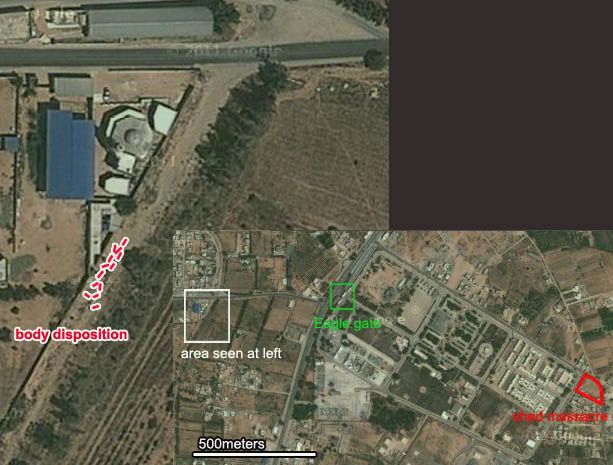last update March 29, 2012
Here we'll explore a rebel military leader and his base of operations, both previously mentioned in connection to criminalizing Gaddafi support in liberated Libya. There may be no significance to the shed massacre, but it's the possibility of one that made me post this. Below, discussion may develop the ideas further and give more clarity. To start with, a widely-re-posted but little-followed-up-on AP article.
Ex-Libya rebels search homes of Gadhafi loyalists
Karen Laub, AP, Sept. 6 2011
TRIPOLI, Libya — Former rebels, weapons drawn, burst into the houses ofsuspected supporters of Moammar Gadhafi, searching rooms and hauling away military uniforms, a portable safe and documents that appear to link residents to the deposed regime.[...]
In Khalet el-Furjani, a neighborhood of about 4,000 people, the undisputed boss is now Hussein Furjani, who temporarily traded his white preacher’s robe for military fatigues after rebel fighters rolled into Tripoli on Aug. 21.A photo of the sheikh (AP, Francois Mori) reviewing "possibly incriminating" documents (issued by the old government) can be seen at this Washington Post page.
Furjani heads the local military committee and operates from his mosque. On Tuesday, he gave orders from an office chair in the mosque courtyard, sporting dark shades and a turban, while cradling a Belgian assault rifle and a walkie-talkie.
Furjani's HQ, then, is this mosque/military base for Tripoli's fifth column, rising with the rebels as they arrived to topple the government. It was shown to journalists in early September, its yard stuffed with police motorcycles and hundreds of household items, ostensibly taken from looters to return to its owners, largely the government and fled/dead loyalists. (some of it seen here)
As the base of local fighters in Khelet al-Furjan during the August fighting, it's a possibly significant locale in our study of war crimes there. Black men were taken prisoner up and down al Hadbah road, a north-south thoroughfare the mosque may sit just off of (see below). Furjani's men didn't likely take on the Yarmouk military base, a half-kilometer away, at least not by themselves. But Misrata brigade fighters rolled through apparently late on August 23, and found about 140 extremely messed up dead people in the NATO-bombed compound.
These guys might have helped, providing a base with the mosque for more deilcate operations. There can't be many miosques in the neighborhood, so this might be the same one behind which 22 bodies, mostly or all black men, were found executed on August 26. For reference, here's the satellite imagery of that area and where 13 of the bodies were situated -near the doorway connecting this old wadi/road with one of the buildings inside the wall.
March 25: A Dr. Salem Link?
The name of the local commander, Shiekh Hussein Furjani, immediately raises the possibility of relation to Dr. Salem al-Farjani, aka local "witness" to the shed massacre, Dr. Salim Rajub. Looking at the photo of the sheikh linked above, he can't be the same man, nor the 70-year-old father he reportedly took with him to massacre sites he was investigating and/or lying about. The beard and sunglasses obscure his face, and the headdress covers his hairline, making facial matching difficult. They do look possibly related. The best clue is the stubby arms and pudgy fingers, not unlike those of "Dr. Rajub." Visualize a blue short-sleeved shirt, and we might have, say, an older brother.
The same al-Farjani/Furjani family fielding a preacher and rebel commander, and a doctor and rebel "forensic scientist?" Sure, why not? It would explain how a transparent idiot like al-Farjani was given such a delicate task. The local fighter knows a massacre of their Misratan comrades (and/or themselves). He has a brother who's sort of a doctor, who can enlist his hospital's help identifying the dead. It could explain where Dr. Rajub said he was when the massacre happened: "here at this mosque." His brothers' mosque, where the local fighters were based?
March 29: Not that mosque.
I was so late in adding that thought, Petri and Felix debunked part of it it months ago and it didn't sink in with me. Furjani's mosque appears to be larger and with different windows than the small mosque near Yarmouk which, by a photo of about that time, looks almost abandoned. The 22 "mercenary"looking dead guys were apparently not dumped behind his (main) mosque.
The possibility of a Furjani-Farjani connection does, however, remain, however speculative and remote it might be.


there is a photo of the Khamis Brigade mosque on Panoramio:
ReplyDeletehttp://www.panoramio.com/photo/45947208
It does not look like the mosque seen in the photos of Hussein Furjani.
The windows of the Sheikh's mosque, behind the yard filled with Harley-Davidson , seen in this Mathaba piece, 12 September 2011, Mosque preacher leads looting of civilian houses in Tripoli, are of a completely different design. I wonder where it is? I take it that the guy with specs is the engineer, Mohammed Shiriana? On a main road, with a checkpoint....
ReplyDeletenot this one either .
Delete